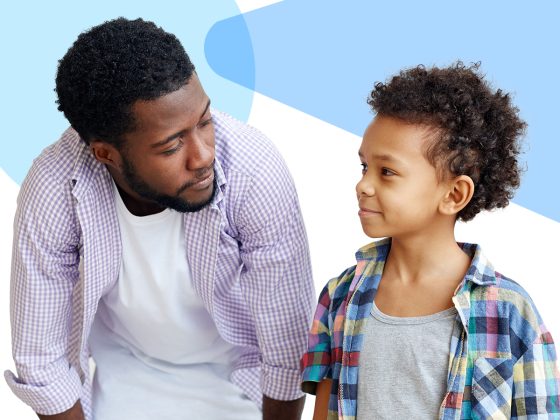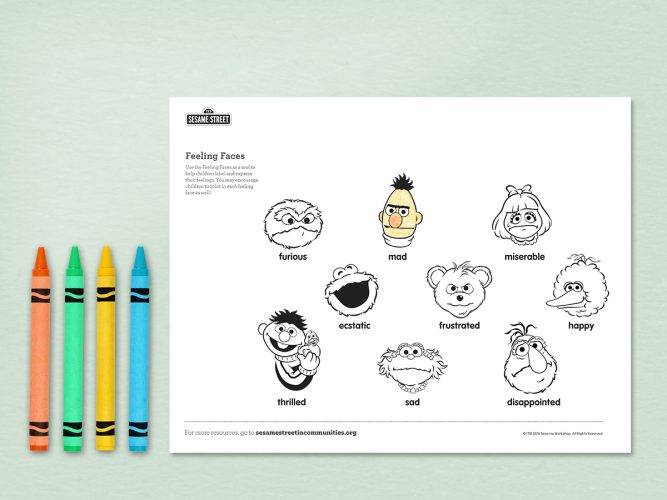
Talking with Kids About Feelings
Social-emotional learning can be part of your everyday activities!
For kids, learning to understand, express, and manage their emotions is just as important as learning the abc’s. And it’s possible to support kids in this learning through simple, fun, everyday activities.
When you incorporate social-emotional learning into your everyday routines, you help kids build healthy emotional habits. A few simple activities can go a long way to helping children develop self-awareness and empathy.
Starting with the self
For children, social-emotional learning begins with identifying feelings. Recognizing and naming feelings helps children understand them. And there are lots of activities that you can do that will help children in this process.
- Name that feeling – a great first activity is to simply give feelings names. Gather pictures from magazines or books in which a person is showing a clearly identifiable feeling. Ask kids, “What do you think this person is feeling?” and help them name the emotion. You can write down the feeling names on a piece of poster paper and attach the pictures so children can see them all the time.
- How are you feeling?– Using the feelings poster above, integrate feelings talk into regular meeting times. Point to a feeling and ask questions like, “What is the person feeling? Have you ever felt like that? What did it feel like? What made you feel that way?”
- Feelings art – Use art time to do a feelings check in. Have children make a self-portrait in which they are showing a particular feeling. Once everyone is done, ask if any children want to talk about the feeling shown in their portrait. You can make this a regular activity to help children build a portfolio of feelings.
- Feelings check in – Create a simple feelings chart that shows emotions like “happy”, “sad”, “angry”, “frustrated”, and “excited” through pictures and words. Write each child’s name on a slip of paper. When a child arrives for the day, ask them to identify how they are feeling in the moment, and stick their name to that feeling with tape. Invite children to update their feeling status throughout the day, and if they do, use that moment to ask how their feelings have changed. This can be adapted to be more private, by creating a feelings box. Have children write their name and feeling on a piece of paper and put it in the box, then you can look later and invite children to share more with you if they want.
The feelings of others
Once children have learned to name their own feelings, they can start to recognize that other people have the same feelings as well. Recognizing the feelings of others is the key to developing empathy.
- Story time – Reading together provides a great opportunity to understand the feelings of others. As you are going through a story, pause to ask questions like, “How do you think this character is feeling? Have you ever felt this way?” or “What makes you think this character is feeling this way?”
- Emotional charades – Write down different feelings on slips of paper and draw a picture of the feeling next to the word. Put the feeling slips into a hat or bowl. Have children draw a feeling out of the hat, and act it out using only their face and body. Have the other children guess what feeling is being acted out. After each turn, ask “What made you realize that was the feeling?” and “What is a time that you felt that way?”
- Your own feelings – A great way to teach children about the feelings of others is to talk to them about your own feelings. During the day, use feeling words when making announcements or pointing something out, like “It makes me so happy to see everyone playing together. Can you tell that I am happy? How?”
Managing Feelings
For children, recognizing their own feelings, and the feelings of others is the most important social-emotional work that they can do. But helping them name and talk about feelings when they are experiencing really big emotions can be hard. So having calm down strategies they can do before they talk about feelings can be key.
- Bellying breathing practice – Start each day in a circle and have children put their hands on their bellies. Have them take a deep breath in, filling up their bellies like balloons, then breathe out, deflating the balloon. Have them do this three times. By doing it everyday, you are building a calming habit.
- Belly breathing through tough moments – If a child is having big feelings that are out of control, get down at eye level and say, “let’s belly breathe together.” Take the three deep breaths with them. Once they have calmed a little, ask them to name the emotion they are feeling.

Social Chat: Talking About Feelings
We can incorporate social-emotional skills, such as learning and talking about feelings, into our everyday activities.

Talking About Feelings: Tips & Tools for Providers
We can incorporate social-emotional skills, such as learning and talking about feelings, into our everyday activities.

Feeling Faces
Understanding and expressing feelings is another important coping skill for children and adults.
